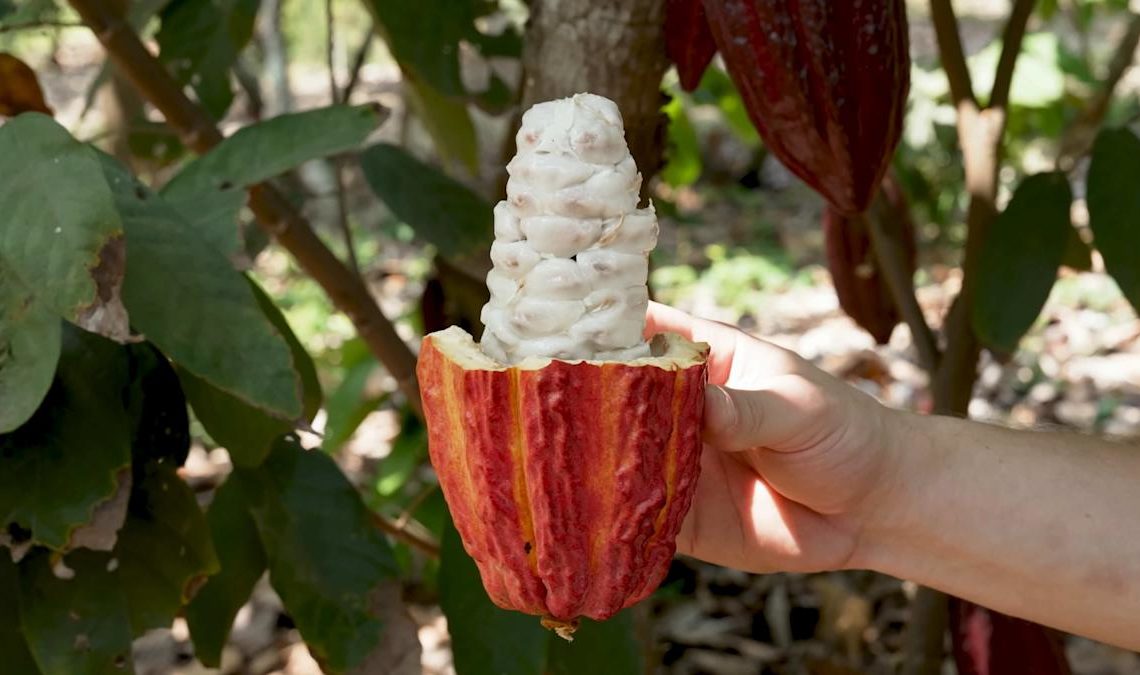Chocolate is one of the most popular foods on the planet. But did you know it comes from a weird-looking fruit shaped like a dinosaur egg? I went from farm to factory to show you exactly how chocolate is made, and then worked with a chocolate maker in Ecuador to build the world’s largest chocolate bar. This became a chocolate extravaganza that no sweet tooth could deny.
Chocolate grows on… trees?
It all begins with the cacao tree. Tiny budding flowers on a branch eventually grow into big colorful pods, and yes, that technically means chocolate grows on trees. I was in Ecuador with my friend Oded — a modern-day Willy Wonka. He’s a little wild, just like Wonka, but he knows more about chocolate than anyone else on the planet.
We started by checking out some freshly-picked cacao pods. When I held one, I was shocked at how much it looked like a giant, colorful ice cream cone. Inside were seeds covered in a thick white pulp, and the pulp is actually edible. You can suck it off the seed, and it tastes like lychee, pineapple, citrus and sometimes even like a sour banana. It was honestly phenomenal. I couldn’t believe this is where chocolate comes from.
An equally delicious byproduct of chocolate-making
There are two main things you can do with the cacao fruit. You can drink the pulp’s juice, and you can make traditional chocolate. First, we visited the place where they make cacao water. It’s kind of like coconut water, but honestly, it is ten times better. The pulp gets separated from the beans, then put into a cold press machine. The result is this sweet, citrusy liquid that gives you a kick, like biting into a tropical paradise.
And if you want to get creative, you can turn that pulp into cacao fruit leather. I love making fruit leather, so this was right up my alley. They even had chewy cacao snacks that looked a little like ground turkey while they were being made. With chocolate being such a giant industry, I was glad to see the rest of the fruit getting put to good use as well. This way, there’s less waste when it comes to chocolate-making.
Ferment, dry, repeat
Now that the white pulp has been removed and reused, it is time to focus on the beans. These seeds go through fermentation, which is one of the most important parts of the process. Without it, the chocolate would taste bland, bitter and boring. I smelled the beans mid-fermentation, and they reminded me of sourdough bread — kind of yeasty. After a week or so of fermentation, they were ready to be dried in the sun.
Chocolate makers lay the beans out in the hot Ecuadorian sun and flip them every 15 to 30 minutes. There was so much of it that I jumped onto a pile and made a chocolate snow angel. Once they’re dry, the shells are broken open to reveal cacao nibs — the same stuff you might see on a smoothie bowl. If you grind those up into a paste, just like you would peanuts into peanut butter, that’s the base of chocolate. Just add sugar, and you have yourself a rich, creamy treat. My next stop was to explore one of the biggest chocolate brands in the world to see how they can take this paste and create something iconic.
Willy Wonka has nothing on this place
What’s more iconic than a Hershey’s Kiss? I took a trip to the Hershey’s factory in Pennsylvania, which is about as close as you’re going to get to the real-life Willy Wonka factory. Inside, there were giant hoses pumping out chocolate paste, which had just come from the cacao paste I saw in Ecuador. That same paste gets used to make everything in the factory, from Hershey’s Kisses to giant chocolate bars.
Watching the Kisses being made was mesmerizing. The machines run 24 hours a day, making 70 million Kisses daily. The name supposedly comes from the motion of the machine dropping the chocolate onto the conveyor, like a kiss. Each Kiss goes through quality control, gets cooled in a tunnel, and then wrapped with foil and that little flag. I couldn’t stop wondering how many I’ve eaten in my life, and it was so cool to see where they came from.
The great chocolate expedition
Now it was time for the main event. I learned the ins and outs of chocolate and felt confident enough to make my name in the industry. One thing I know how to do best is break a Guinness World Record, and this was the perfect opportunity to do that. We needed to build a 400 square meter chocolate bar — that’s bigger than a full-sized basketball court and would weigh 22,000 pounds. If you ate one square a day, it would take 30 years to finish.
We couldn’t build it outside, because it was 95 degrees in Ecuador. The chocolate would become liquid before even touching the ground. So, we moved into a giant warehouse with AC. Guinness has strict hygiene rules, so my team and I put on hairnets, cleaned up and wore covers on our shoes. Then it was showtime.
We started placing bars down in the middle of the mat. Each one had to be glued together using a bag of melted chocolate. It was like a giant chocolate hot glue gun. My friend Patrick and I got competitive about who could lay their section better and faster. Goes without saying that I was the better chocolate bar builder. The key was to stay cool, calm and collected.
Total meltdown
Just when we were getting into a rhythm, the lights went out. Total power outage. No lights, no AC. In Ecuador, the energy grid sometimes cuts out randomly. We had backup generators, but even they went out. We had flashlights going while people kept working, but if the temperature rose above 80°F, the whole bar would melt.
My friend Dennis, who was the health inspector for this project, checked the temperature. It was 75 at the time — only five degrees away from total disaster. You could see the chocolate starting to lose its shine, and I was panicking. Oded said there was no solution — not even in his chocolate Bible.
Then, finally, the power came back and the AC started going. We could feel the cool air again, and it was a giant relief knowing that we still had a shot. I feared that the power would go out again, but luckily, it stayed on through the rest of the project.
Army of Oompa Loompas
To get this done quickly in fear of another power outage, I brought in extra help. Once the lights came back on, we had about 80 rows done out of 106. Time was running out, but we kept going. At one point, it looked like a chocolate mirror since it was so shiny. That shine meant we had tempered it perfectly, which also gives it the perfect snap.
We kept checking on different corners, helping close the gaps where it was falling behind. People were covered in chocolate. When I asked one guy if he wanted to get into some new clothes, he said it was fine because he loves chocolate. That’s passion and dedication if I’ve ever seen it.
We started at 7:30 a.m. and by 7:30 p.m., we had just ten squares left. Patrick led the countdown: nine, eight, seven… all the way down to one.
400 square meters of glory
We stood back and looked at what we had made. After 22,000 pounds of chocolate and tons of teamwork, we had built the world’s largest chocolate bar. The Guinness official took measurements just to confirm. The old record was 383 square meters. Ours was 400. We had officially broken the world record.
Chocolate for everyone
None of this chocolate went to waste. We broke it up and gave it to kids all over Ecuador. And yes — we finally got to try a taste for ourselves. It was delicious!
This whole experience gave me a new level of appreciation for chocolate — not just the flavor, but the process, the people, the history, the science and the scale. From a tiny flower on a cacao tree to a 22,000-pound world record, every step was hands-on and full of surprises.
Chocolate doesn’t just come from a factory; it comes from real farms, real sun and real people who know the craft inside and out. There’s a story behind it all, and for that, I’ll never look at a Hershey’s Kiss the same way again.
Catch the full story in my video below!
The post What it takes to make the biggest chocolate bar in the world appeared first on .




